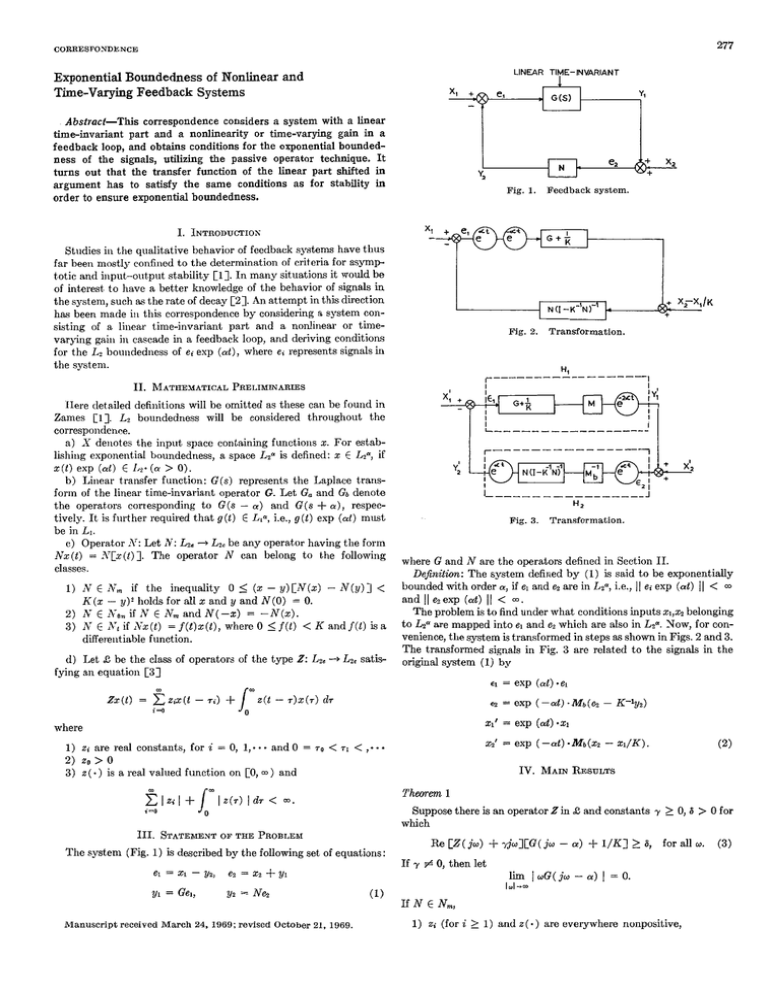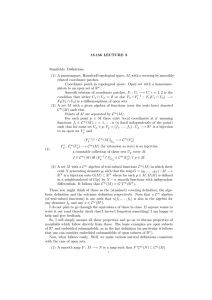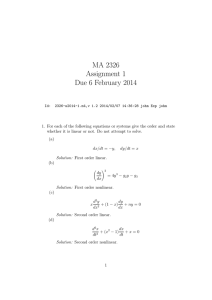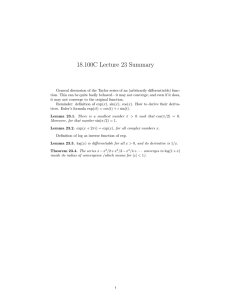Document 13682407
advertisement

277 CORRESPOhmENCE LINEAR TIME-NWRIANT Exponential Boundedness of Nonlinear and Time-Varying Feedback Systems Absiracf-This correspondence considers a system with a linear time-invariant part and a nonlinearity or time-varying gain in a feedback loop, and obtains conditions for the exponential boundedness of the signals, utilizing the passiveoperator technique. It turns out that the transfer function of the linear part shifted in argumenthas to satisfy thesame conditions as forstability in order to ensure exponential boundedness. Fig. 1. Feedback system. Fig. 2. Transformation. I. INTRODUCTIOS Studies in the qualitativebehavior of feedback systems have thus far been madly confined to thedetermination of criteria for a s y m p t.otic and input-out,put st.ability [I]. In many situations it would be of interest. to have a bet,ter knowledge of the behavior of signals in the system, suchas the rateof decay [2]. An att,empt in this direction has been made iu this correspondence by considering a system consisting of a. linear time-invariant. partand a nonlinear or timevarying gain in cascade in a feedback loop, and deriving conditions for the L2 boundedness of e<exp ( a t ) , where e, represents signals in the system. 11. NATHENATICAL PRELIN~ARIES Here deta.iled definitions will be omitted a.s these can be found in considered t.hroughout the Zames [I]. L? boundedness willbe correspondence. a) X denotes t.he input, space containing funct,ions z. For establishing exponent,ial boundedness, a space Lz* is defined: z E L f , if x(t) exp ( a t ) E ( a > 0). b)Lineartransferfunction: G(s) represents the Laplace t.ransform of t.he linear t.ime-invariant operator G.Let G, and G b denote the operat.ors corresponding to G(s - a) and G(s a ), respectively. I t is fnrther required that g ( t ) E L l a , i.e., g ( t ) exp ( a t ) must be in L1. c) 0perat.or Let X: Ln. + be any opera.tor having the form -Vx(t) = A ' [ x ( t ) ] . The operator N can belong tothe following classes. I I + J Hz Fig. 3. Transformation. A V : X m if the inequality 0 5 (x - y)[N(z) - -V(y)] < K ( x - y)* holds for all x and y and A'(O) = 0. 2) S E X O , . if E X m and X ( -z) = - N ( z ) . 3) X E IYt if X x ( t ) = f ( t ) x ( t ) , where 0 5 f ( t ) < K a n d f ( t ) is a differentiable function. 1) B E d ) Let G be the class of operators of t,he type 2:L?, -+ Lze satisfying an equation [a] m zz(t) = x Z C C ( t -~ i=Q where i + ) L- z(t - - m) d7 T ) ~ ( T ) - - - and 0 1) zi are real constants, for i = 0, 1, 2) 2 0 > 0 3) z ( ) is a real valued funct.ion on [0, where G and N are the operators defined in Section 11. Definition: The system defined by (1) is said t o be exponent.ially bounded with order a,if el and e~ are in Lf,Le., 11 ei exp ( a t ) 11 < m and 11 e e x p (at) 11 < m. The problem is t o find under what conditionsinputs Z I , belonging ~ t o LUare mapped into el and e which are also in LP. Now, for convenience, the system is transformed in steps as shown in Figs. 2 and 3. The t.ransfonned signa.ls in Fig. 3 are related to the signals in the original system (1) by = T~ < T~ < ,.- - and Theorem 1 Suppose there is an operator 2 in 6: and constants which 111. STATENENT OF THE PROBLEM The system (Fig. 1) is described by thefollowing set of equations: el = 51 - y ~ , e2 = 22 yl = Gel, + yl Re [ Z ( j w ) If y # 0, then let + -j+][G(jw - a) + l/X] lim I wG(jw - a) I = 2 6, y 2 0,8 > 0 for for all 0. yz = N ~ z Manuscript received March 24, 1969; revisedOctober 21, 1969. 1) zi (for i 2 1) and z ( - ) are everywhere nonpositive, W. (3) 278 IEEE TBAWSXCTlONS ON AUTOhL4TIC COSTROL, APRIL 1970 Comments on “On the Optimal Angular Velocity Control of Asymmetrical Space Vehicles” Abstract-The purpose of this correspondence is toexplain the surprisingly simple feedback laws derived by Debs and Athans in their paper,l and to indicate a broader class of systems that can be solved by this approach. then 1; el exp (ai)11 < m and e, exp (at) 11 < m . Two useful lemmas which can be easily derived are stated first. I. S-Y Lemma 1 OF THE RESULTS OF The state equations of the system are Let. P be any positive (strongly positive) operator; let T be a time-varying gain whose derivative exists almost everywhere. Then rP is positive (strongly positive) if T is posit.ive and nonincreasing dmost everywhere. 21 = alZ?za Lemma 2 Let Q be a positive (strongly positive) operator; let r be a timevarying gain. Then rQr is posit.ive (strongly positive). PToof: Let x E IT,,,. Referring to Fig. 3, let 11f = z(j w ) ~ j + where conditions 1) and 2) hold. Now, the inputs to the system are in L.H I k strongly positive as per (3) and Lemma 1. X * ( j ~ =) M (j w a) and hence, MI, also belongs to the class of allowable multipliers for AT,,,[SI. Hence, H? is positive from Lemma 2. Thus, from a well-knom theorem of Zames [l], and €2 are in Ls. From (2) it follows that el and e2 are in L a . The result for N E N o , can be established similarly using t,he corresponding mult.iplier. These resdts can be improved by extending the interval of definition of the mult,iplier from [0, m ) to ( - Q , m ) ~41. + w = a223X1 53 = afl12s 1 ) H ( s - j3) is strictly positive real (SPR); 2) H ( s ) [ G ( s - a) 1 / K ] is SPR; 3) f I 2Bf(l - f/K). + JI = + + X?) + (l/q)(ul2+ US’ + 2 (~(zI’ 5 2 ’ l[ where p 1 dt (2) up = -px2, u3 = (3) -qx3. If the performance index is JZ = [ IpCf~(xd+A(m)Cf3(23)1 (4) where ft(-) and g l t ( - ) , k = 1,2,3, are positive definite functions of a single variable such that fk(0) k = 1,2,3, gt(0) = 0, = 0, Q > 0. The control law which minimizes ( 4 ) is PTooj: Fig. 3 reduces t.0 a linear system G(s - a) f 1;‘K with a time-varying feedback gain ( f ( t ) ) / ( l - f ( t ) / K ) when N E N t . The Theorem follows from earlier results [5] recast in a functional setting. Some recent results of Freedman and Zames [6] can also be used here. These involve a v e r e e logarkhmic variation criteria on j ( t ) in contrast t o condition 3). u1 = -qh1(21), h t ( 0 ) = 0, h,t-l(.) exists, REFERENCES 1 .11. G. Zames. “On the inDut-outout st,ahilit.v of time-xrarrine nonlinear feedback system, pt. I < c o n d i t i ~ n s ~ d e r i ~ . e d uii&ip:s sin~ of loop gain, conicit,y, and positivity IEEETrans. Automatic Control. vol. AC-11, pp. 228-238, April i966. - “On theinput-output stabllay of time-varyin* nonlinear feeddack systems,pt. 11: con$tions involving circlesoin the freauencv Dlane and sector nonhnearit.ies.” IEEE Trans. Automatic I21 I31 > 0, and gl;!ut) = nonlinearities,” S I A M ‘ J . Control, vol. 6, no. 1, pp. 891U8, 1 Y 6 8 . [5] M . Gruber and J. L. W i e m s , “On a generalization of the circle crit,erion,” PTOC.4th Ann. Allerton Conf. Circuzt and System Theory, 196% nn _=. 837--RA!? 161 M . I. Freedman and G. Zames, “Logarithmic variation criteria for thestability of systemswithtime varying gains,’’ S I A M J . Controt, vol. 6, pp. 48‘7-505, August 1968. h’ hk(2) n’[(-ut/p)hk-l(-Uk/Q) x1 # 0, X. = 1,2,3 ax - fk(hk-’(--lLk/Q))l. 11. EXPLANATION OF THE RESULTS The results of the optimization problem considered in Section I become obvious if the corresponding optimization problem of a n equivalent system is considered. Thesystem equivalent to (1) for the performance indices considered is the simple decoupled linear system giwn by x 1 = u1 x 2 - “Stability. conditions for svstems with- monotone and slope (5) u3 = -ph3(xa) hk(~l;)~l; fk(2d = H. S. RXYGANATH Dept. of Elec. Engrg. Indian Institute of Science Bangalore 12, India u2 = -qhr(Zd, where hl;(- ) are continuous and differentiable scalar valued functions of a single variable such that M. A . L. THATHACHAR -_--. --. ---. [fa2) > 0, the optimal feedback control law is u1 = -qx1, + resJr&Jed (1) + (l/dcg*(Ul)+ gn(u2) + 93(~”)11dt The system (1) with 11’ E Nt is exFonentially bounded with order if there e.nists an H ( s ) such that [41 x2 + u1 + US + u3 t hf a2 a3 = 0. Corresponding to a performance index which is to be minimized, given by ~ Themem 2 a DEBSA X D ATEL~SS~ = u2 53 = ua. Manuscript received October 9, 1969. 1-4. S. Debs and M. bthans, I E E E Trans. Automatic Control (Short Papers), vol. AC-14, pp. 80-83, February 1969.






